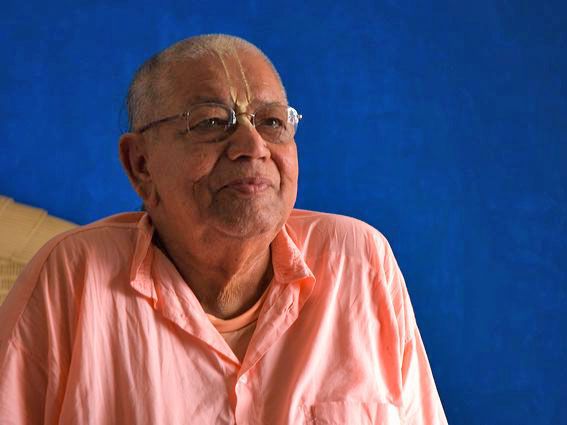The necessity of subservience to Guru–Vaisnava.
By Srila Bhakti Sundar Govinda Dev-Goswami Maharaj
An editorial
translated from the original Bengali text
published in Sri Gaudiya Darsan,
Volume 5, Issue 11, Friday, 10 June 1960.
What is bhajan? The service of that which is to be served (bhajaniya-tattva). Even if the conception of ‘that which is to be served’ finds a place in the hearts of men in many different forms, still the revelation of the form of ‘that which is to be served’ in the pure, clean heart is the Lord Himself. The Lord’s fundamental, original form is Nanda Nandan Krishna, the Akhila-rasamrta-murti [the embodiment of the nectar of all rasas] celebrated by the highest section of liberated souls.
isvarah paramah krsnah sach-chid-ananda-vigrahah
anadir adir govindah sarva-karana-karanam
(Sri Brahma-samhita: 5.1)
[“The embodiment of spiritual energy, consciousness, and ecstasy, Sri Krishna, who is known as Govinda, is the Supreme Lord of all Lords. He has no origin, He is the origin of all, and He is the cause of all causes.”]
This is the conclusion of the Vedas, Vedanta, Gitopanisad, and other scriptures. Thus, that which is to be served is none other than Sri Krishna, Power Himself accompanied by His Power (Sasakti-saktiman). Sri Krishna’s service cannot be performed by a soul with mundane ego. Srila Rupa Goswamipad has said,
atah sri-krsna-namadi na bhaved grahyam indriyaih
sevonmukhe hi jihvadau svayam eva sphuraty adah
(Sri Bhakti-rasamrta-sindhu: Purva-vibhaga, 2.234)
[“Although Krishna’s Name, Form, Qualities, and Pastimes cannot be grasped by the material senses, they manifest themselves on the tongue and to the other senses according to one’s service attitude.”]
We can understand from this verse also that Krishna’s Name, Form, Qualities, Pastimes, associates, and identity are all supramundane. He only bestows His mercy and reveals Himself to the senses of the soul who is qualified and devoted to His service.
Sri Gaurasundar also said, “Aprakrta vastu nahe prakrta gochara: supramundane existence is not materially perceptible.” A genuine servant of Krishna is also supramundane. Furthermore,
diksa-kale bhakta kare atma-samarpana
sei-kale krsna tare kare atma-sama
sei deha kare tara chid-anandamaya
aprakrta-dehe ta̐ra charana bhajaya
(Sri Chaitanya-charitamrta, Antya-lila, 4.192–193)
[“At the time of initiation, a devotee surrenders themself, and Krishna accepts them. Krishna makes the devotee’s body spiritual and joyful, and in that supramundane body the devotee serves Krishna’s feet.”]
In truth, a devotee dedicated to Sri Krishna’s service resides in the supramundane realm and serves Krishna with a supramundane body. A soul’s pride in considering Krishna’s service mundane is nothing more than self-deception.
Here there is a question. “Maya-baddha jivera nahi Krishna-smrti jnana: souls bound by maya have no consciousness of Krishna.” So how is it possible for souls to attain such fortune?
Answer: The solution to this problem is the appearance of sadhu, guru, and scripture.
Question: But how will the soul attain them?
Answer: Only by subservience (anugatya). Yes, subservience is the only way to attain Krishna’s service. The inclination to serve Krishna will arise in the heart as a result of subservience to a devotee engaged in supramundane service.
The sadhus and scriptures disparage the soul’s freedom in all respects and teach that submission to the Lord is the sole path to be followed. A relationship with the Lord Himself is possible only through the sadhus’ association (satam prasangad). The life of the Vaisnava sadhus is subservience. The activities of their senses are engaged in Krishna’s service twenty-four hours a day.
Tulasidas wrote,
santa bade paramarthi, sitala unki am
tapana budhayata aurake dharayata apana ram
Thus, as soon as one can make one’s mind and activities like the minds and activities of the sadhus, which are fully established in the soul’s dharma—the dharma of Krishna’s service—so soon one will become fulfilled.
Sri Krishna is served by His supramundane servitors through undeviating devotional practice (avyabhichari bhakti-yoga). Moreover, without subservience to a genuine devotee of Krishna, devotion cannot become undeviating (avyabhichari). Thus, “Lava-matra sadhu-sange sarva-siddhi haya: all perfection is realised within a moment of association with sadhus.” This principle is an eternal truth. In the prayers to our two wish-fulfilling Acharyas we see:
govindabhidham indirasrita-padam hastastha-ratnadivat
tattvam tattvavid-uttamau ksiti-tale yau darsayan chakratu
[“Sri Rupa and Sri Sanatan, the highest knowers of the Truth, show Govinda, at whose feet Laksmi Devi (wealth itself) is sheltered, to the world as though He is a jewel in their hands.”]
Thus, remaining inattentive or inactive in this regard [in taking shelter of the Vaisnava] is the soul’s one and only misfortune. Kim adhikam iti: what need I say more?
References
satam prasangan mama virya-samvido
bhavanti hrt-karna-rasayanah kathah
taj-josanad asv apavarga-vartmani
sraddha ratir bhaktir anukramisyati
(Srimad Bhagavatam: 3.25.25)
[The Lord says:] “In advanced association with the sadhus, discussions become full perceptions of My Pastimes and elixirs for the heart and the ears. By cherishing them, faith, attachment, and devotion to Me—the path to the highest attainment—quickly develop.”
man cha yo ’vyabhicharena bhakti-yogena sevate
sa gunan samatityaitan brahma-bhuyaya kalpate
(Srimad Bhagavad-gita: 14.26)
“One who, without deviation, serves Me exclusively with devotion, transcends the modes of material nature and becomes fit for spiritual perfection.”









